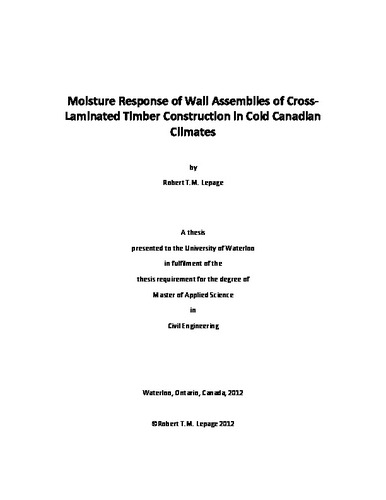| dc.description.abstract | Wood is a highly versatile renewable material (with carbon sequestering properties), that is light in weight, has good strength properties in both tension and compression while providing good rigidity and toughness, and good insulating properties (relative to typical structural materials). Engineered wood products combine the benefits of wood with engineering knowledge to create optimized structural elements. Cross-laminated timber (CLT), as one such engineered wood product, is an emerging engineering material which provides great opportunities for the building industry.
While building with wood has many benefits, there are also some concerns, particularly decay. Should wood be exposed to elevated amounts of moisture, rots and moulds may damage the product or even risk the health of the occupants. As CLT panels are a relatively new engineered wood product, the moisture characteristics have yet to be properly assessed. Consequently, the amount of decay risk for CLT in building applications is unknown, and recommended protective actions during design construction and operation have yet to be determined.
The goal of this research was to determine the moisture durability of CLT panels in wall assemblies and address concerns related to built-in construction moisture. The approach used to address the problem was to first determine select moisture properties of CLT panels through experimental approaches, and then use the results to calibrate a hygrothermal model to quantify the risks of wall assemblies. The wall assemblies were simulated in six different cities across Canada, representing a range of climates: Vancouver, B.C., Edmonton, A.B., Winnipeg, M.B., Ottawa, O.N., Québec City, Q.C., and St. John, New-Brunswick. The risks associated with moisture exposure during construction are also considered in the simulations.
The experimental phase of the research was limited to moisture uptake tests. These tests were utilized to determine the liquid water absorption coefficient for four different types of full scale panels (2’x2’) and 12 clear wood samples. The panels were either made of 5-ply of Western-SPF, Eastern-SPF, Hemlock-Fir, or 3-ply of a generic softwood provided by a European CLT manufacturer; the clear samples were all cut from the same nominal 2x6 SPF-grade lumber. The panels were installed in a drying rack and gravimetrically tracked to assess the drying rates of the panels. Finite resources precluded more thorough material testing, but a parametric study was conducted to determine the relative impact of the missing material data on the final simulation results.
In the hygrothermal simulations, four main wall assembly types were considered- those with either exterior or interior insulation, and those using either vapour permeable or impermeable air-water barriers. Various types of insulation and vapour control were also modelled. The simulations were run for a variety of interior relative humidities. The metric for comparison between the simulations was the water content of a 4mm thin layer on the extreme lamina of a CLT panel system.
The results of the simulation suggest that vapour impermeable membranes, when install on dry CLT panels (less than 14% M.C.) do not pose moisture risks in any of the climates considered. However, when high levels of construction moisture is considered, only vapour permeable membranes controlled moisture risks by allowing the CLT panel to dry both to the interior and to the exterior. | en |

